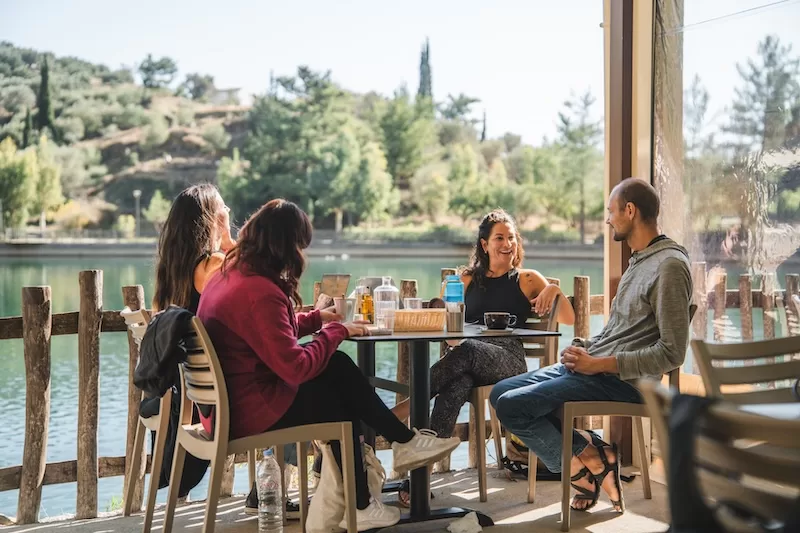Co-Living in Crete
Culture and connection at a nomad retreat in the Greek isles

Imagine waking up to the sound of birds chirping in harmony with a gentle Mediterranean breeze, sipping your coffee while gazing at majestic, myth-inspiring mountains, and ending your day sharing stories with people from around the world.
It’s not a dream—it’s daily life at a calming co-living destination in Crete my husband Alex and I thoroughly enjoyed last month. I’ve been a digital nomad for about three years, hopping from place to place in pursuit of adventure and inspiration.
But the glossy Instagram-worthy lifestyle comes with its own challenges, and loneliness—even for us, a couple—may be the hardest to overcome.
Overcoming Solitude
Being constantly on the move means missing out on close connections and the sense of community people need. I’m not alone in this struggle. Recent research shows that one out of four remote workers grapple with loneliness.
Many nomads have responded by embracing co-living, the increasingly popular concept of shared residences for long-term travelers. For a reasonable rate, you get your own room, and everybody shares the kitchen and common spaces.
Some guests stay for a week, others for a year. Nowadays, you’ll find co-living spaces at every price point at just about any decent destination, from Barcelona to Bansko, Berlin to Buenos Aires, Bangkok to Beijing, and beyond.
Read More on Here Come the Executive Nomads
The New Way to Co-Live
Co-living retreats combine productivity, connection, and adventure to create the perfect work-cation. On these retreats, anywhere from several to several dozen people gather in a specific locale for a set period, usually from a week up to a month.
Today there are dozens of different co-living retreats—you can be on a boat, in a treehouse, focus on yoga, sailing, cooking, hiking, and more. When my husband and I read about Avnea’s Nomad Village, which encourages nomads and solo-preneurs to live, work and grow together, we were immediately intrigued.
The fact that it was on the beautiful Greek island of Crete sealed the deal. Avnea’s Cretan co-living space is nestled in Zaros, a lakeside village of 2,500 people surrounded by mountains, about 25 kilometers southwest of Crete’s capital, Heraklion.

Avnea welcomed 23 guests to this retreat, from 14 countries. We stayed at the Keramos guesthouse, blending tradition and comfort in the center of town. Some rooms offer breathtaking views of the mountains and the sunset, while others overlook the quiet streets.
Our co-working space was the restaurant next door, shuttered for the season. We had full kitchen access and used it to cook a few meals, and also rearranged the space to accommodate meetings. On chilly evenings, we sparked up the fireplace, creating a warm, comfortable gathering place.
Workout Before Crepes
Mornings typically began with an invigorating activity. Tim, a traveler with meditation experience, guided us through a breathwork session. I’d tried meditation before, but Tim’s technique helped me reach a new depth of calm.

Then Lotus, Avnea’s founder-CEO and an aspiring yoga instructor, led us through some movement. She brought a personal touch to every yoga session, tailoring our positions to our energy level. Occasionally the host’s white cat would saunter up to someone in warrior pose or downward dog.
On more intense days, Dan, a fellow guest and fitness enthusiast, led us through HIIT workouts at the town stadium. His sessions were energizing and grueling—I could barely keep up, and the jogging and calisthenics left me with sore muscles and a newfound respect for his discipline.
After workouts, we’d usually head to ZaRous Creperie. Within a few days, the owner started making our coffees as soon as we walked in. His savory crepes were a highlight for many of us.
Quieter mornings meant a stroll to Zaros Lake. Its stillness was almost therapeutic, and the fresh orange juice and omelets at the lakeside café became a personal favorite. I joked with Alex that it was a small indulgence, though I secretly wished we had more time to explore beyond the village on those serene mornings.

When it came time to work, some of us would walk over to the village’s co-working hub, while others preferred the comfort of their hotel room or a shady spot under an olive tree. At lunch we gathered at a local tavern to enjoy traditional meals of fish, olives, feta and more. Sometimes we would cook our own meals in the co-working space kitchen.
Afternoon activities varied, partially since many of us lived and worked in different time zones. A few housemates might keep working, some would head into the mountains for a hike, while others might drive down to Matala Beach, with its laid-back vibe and caves for exploring.

Evenings of Connection
After dinner, we might gather for a masterclass or workshop to exchange ideas and insights on travel, remote work, or staying connected to others. Elena organized a few Greek language lessons to help us feel more comfortable and connect with locals.
Some evenings we would just have fun—a guitar jam session, singing karaoke or a lively game of werewolf. One memorable evening featured an ecstatic dance session at sunset, while another turned into an impromptu discussion about efficient communication and financial independence.
Every night was unpredictable, with the activity and its direction shaped by the diverse origins, talents and passions of the group.
Culture on the Weekend
Weekends were an opportunity to dig into Crete’s traditions. One Saturday our host, Michalis, took us to his family olive orchard just outside the village and handed us tools for harvesting. It was a humbling experience—I had never realized how much work goes into producing olive oil.

Michalis explained how each tree serves a different purpose. Some olives are pressed into oil, while others are destined for table use. Watching him plow the soil and trim the trees after the harvest was almost meditative. He even showed us how they collect snails from the trees to cook later—showing how nothing in the orchard goes to waste.
On those days I felt connected to a way of life that values patience and resourcefulness. From tasting authentic Cretan dishes prepared by village elders ccx to learning folk dances, every moment on the island felt like a bridge between our modern digital world and the timeless rhythms of Crete.
Savoring Life, Finding A Home
Avnea’s nomad village isn’t just co-living, it’s co-creating. Our group balanced work, play, and personal growth. We were productive, yet always found time to savor life’s pleasures.
During our time there, Al and I felt part of a supportive, inspiring community. We found a home and a family in this picturesque Greek village, and we’re already thinking about returning.
If you’ve ever felt the pull of the Mediterranean, the allure of connecting with like-minded people, or the desire to trade isolation for camaraderie, you might want to consider Avnea’s Crete retreat as your next adventure.

———————-
Romania-born Iulia Coman is a software engineer turned content creator and digital nomad. Follow her and her husband Alex’s adventures on Instagram and TikTok.
































